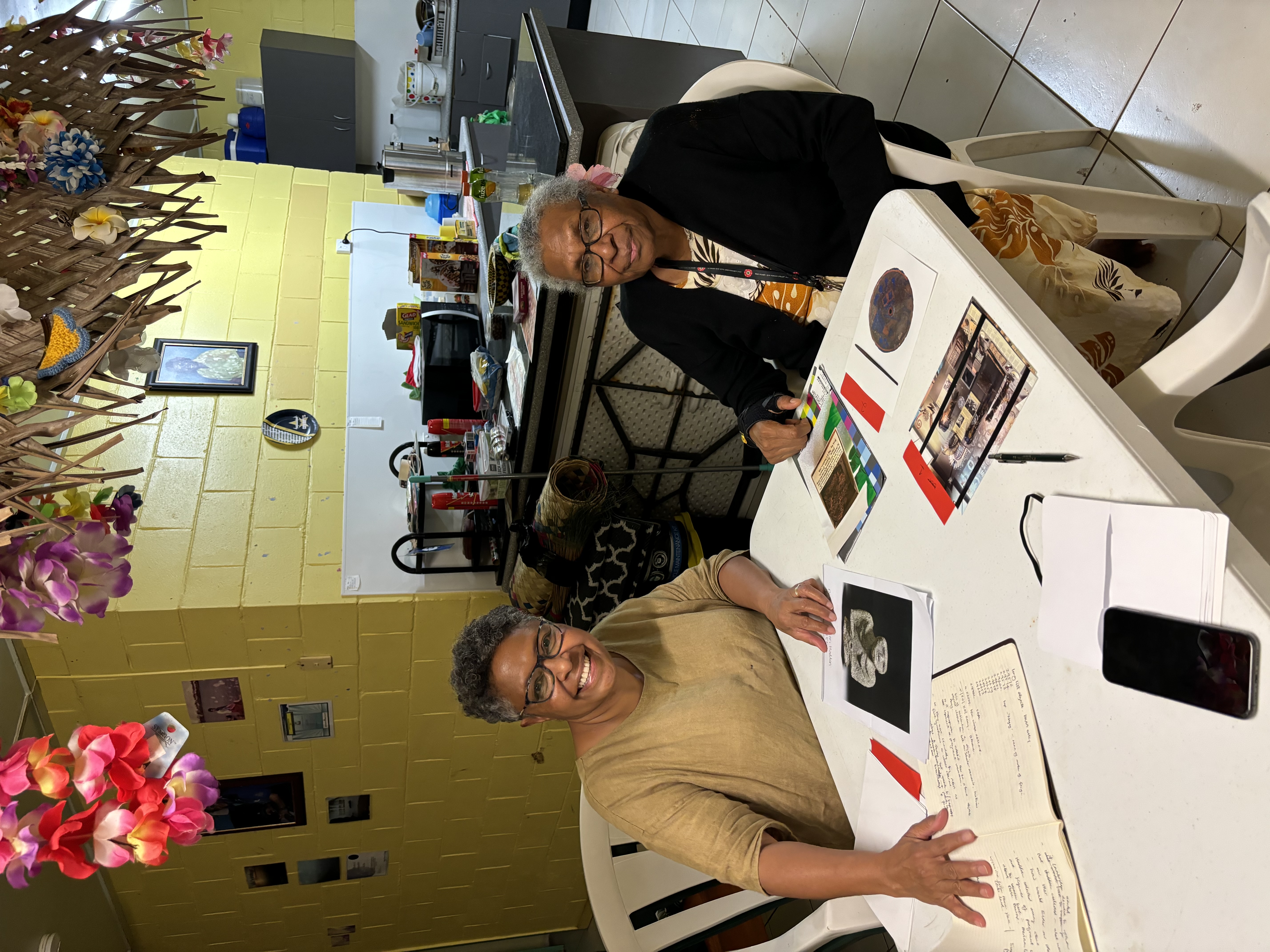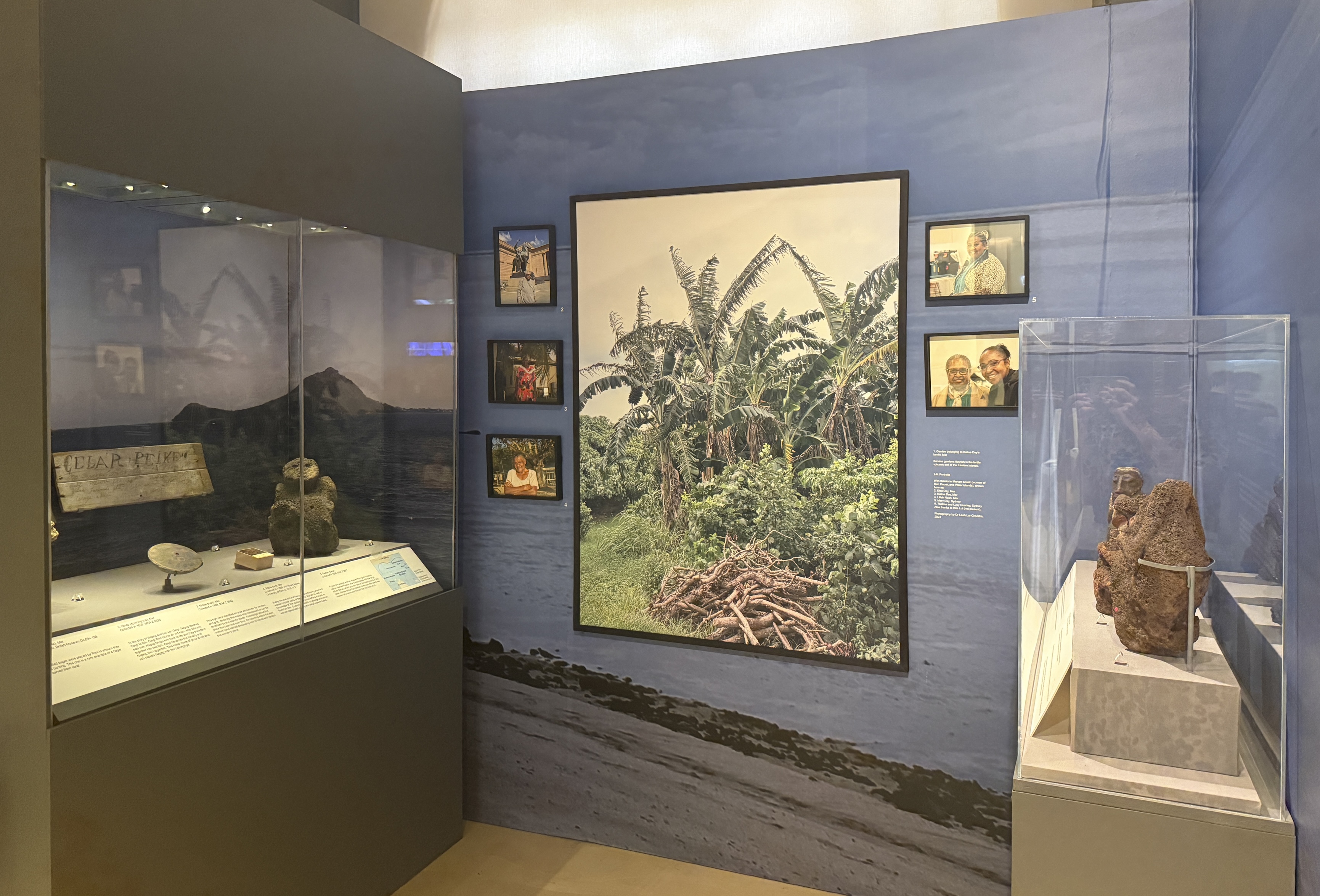07 Oct 2025 | Leah Lui-Chivizhe & Nicholas Thomas
In conversation with the curators of "Fault Lines" (Part 2/4): Leah Lui-Chivizhe
The exhibition Fault Lines: Imagining Indigenous Futures for Colonial Collections, supported by this ERC Starting Grant, opened in December 2024 and will run until December 2025 at the Museum of Archaeology and Anthropology (MAA), Cambridge. A collective, convened by Noelle M.K.Y. Kahanu with Leah-Lui Chivizhe, Taloi Havini and Jordan Wilson, curated this exhibition. In this blog series, they outline the project, through responses to questions prepared by Nicholas Thomas, director of MAA. All parts will appear jointly in a publication that is currently in progress. Read the conversations here in advance.
Leah Lui-Chivizhe
Could you introduce yourself and say something about the place and context you are working from? What are the core issues or priorities that shape your work as an artist / curator / activist / researcher and that you have brought to this particular project?
My name is Leah Lui-Chivizhe, and I am descended from Meriam (Mer, Dauar and Waier islands) and Erubam le people of the eastern Torres Strait Islands. My Dauar ancestor is Wasada, daughter of Zub of Giar Pit and Warima of Er. My totemic affiliations are to nam / green turtle and waumer / frigate. I hold a PhD in history and work as a cultural historian at the University of New South Wales, Sydney.
Over the last 20 years, my scholarly focus has been on teaching about and documenting Torres Strait histories. I first became interested in museum collections in the late 1980s when I researched and wrote about the objects associated with eastern Torres Strait tombstone unveiling practices in Townsville and Cairns, Australia. My current work concentrates on how 19th century museum collections can be utilised to research and write Islander histories of the Torres Strait. This extends on my doctoral research (2012-2016), which examined turtle shell masks taken by Alfred C. Haddon and others throughout the 19th century.
 Leah Lui-Chivizhe (left) and Miss Day (right) meet to discuss the final object selection on Mer Island, Torres Strait, 2024. Photo: Jude Philp.
Leah Lui-Chivizhe (left) and Miss Day (right) meet to discuss the final object selection on Mer Island, Torres Strait, 2024. Photo: Jude Philp.
My motivations for Meriam koskir are twofold. First, to speak to the meagreness of historical records detailing the lives of Torres Strait Islander women throughout the 19th century. In relation to museums, “collectors” were European men who overwhelmingly documented what they saw and took from the vantage point of white male’s perceived superiority. In their early descriptions, Islander women and their activities were often presented as trifling to those of Islander men. Using museum collections to cut a pathway through this loud textual silence, can, I hope, foster interest in researching and writing Islander women’s histories. It might also be useful for the decolonial impulse of colonial-era institutions. Secondly, as the curatorial team began thinking about the geological origins and volcanic renewals of each of our places, I became determined to view documentation on the stone object beings at the MAA. I was delighted that quite a number of the stone beings or objects were relevant to women. After working with MAA staff to identify a dozen or so stone pieces, I consulted with Meriam le in 2024 to finalise the list for Meriam koskir.
In 2022, 2023, and in March and July of 2024, I travelled to Mer, shared information, showed images of the material, and discussed with Meriam le ideas and suggestions for the exhibition. In 2024, I began working with my aunt, Komet elder, Miss Elsa Day. Aunty Elsa shared her general knowledge and stories related to the material, facilitated key consultations on Mer, and aided with Meriam mir language matters. Being able to work closely with her and origin community members more generally was/is crucial for informing and shaping my practice with collected materials. Aunty Elsa and I worked together on the exhibit title, and she confirmed the Meriam mir translation with other Mer elders. As an extension of our work on Mer, University of New South Wales (UNSW) supported Aunty Elsa to travel Sydney where she and I presented on the exhibit’s preliminary work and Meriam mir language teaching at UNSW, and collaborated with Dr Jude Philp to lead a Sydney Torres Strait community engagement with Torres Strait collections at the University of Sydney’s Chau Chak Wing Museum.
Fault Lines addresses the future of colonial-era collections in museums such as the Museum of Archaeology and Anthropology. Could you give us a sense of your engagement with museum collections, and particularly with museum collections such as those in Europe, that are now and have been for decades, if not longer, distant from communities of origin? What in other words are your starting points for imagining the future?
Using colonial-era collections to imagine a future is complicated and fraught on many levels. As a descendant from an origin community, there are very many noisy sites from which to view and work with these collections for imagining Indigenous futures. For me, the primary starting point must be with origin communities. And then there is the question of the future for who or what? Based on my work for this project, future generations of Islanders, the future care of collected things and future hope for repatriation are paramount.
Working with descendants of origin communities, who know little or nothing about how and why the belongings of their ancestors ended up in museums, requires us to work “at the speed of trust”. I also know that the financial resources and time pressures work against the realisation of potential we initially identified. I focused on the stone material knowing that stone requires little conservation or protection. This is important in the context of future repatriation, and thinking about how particular stone objects might be “stored” or regarded if they were returned to the Torres Strait.
When we asked Meriam le what they would do with the stone objects taken by Haddon, if they were returned to Mer, everyone agreed that not all of them would have to be kept wrapped and stored in boxes. Many, they said, could be returned to the places on Mer, Waier or Dauar from where they were taken – for example, in garden areas or beside fireplaces. A starting point for imagining this vision could be to collaborate with Meriam le and use Haddon’s documentation to map images of the stone objects and their associated stories to the actual locations of their taking on each of the islands. I would happily explore the potential for this future project the next time I visit Mer.
 Included are photographs of some of the Meriam koskir (women of Mer, Dauar, and Waier islands) who helped shape or inform the exhibition. Photo: MAA.
Included are photographs of some of the Meriam koskir (women of Mer, Dauar, and Waier islands) who helped shape or inform the exhibition. Photo: MAA.
When the opportunity arose, what artefacts and/or images from the historic collections (at MAA or otherwise in the UK) were you concerned to foreground? What particular significance does the material have?
From the outset, my desire was to work with objects that referenced Islander women’s practices and knowledges. In this vein, the noticeboard Z 9982, which I first saw in 2012, was included to foreground that when it was taken, Meriam le knew that there was an area in the bush just for women and girls. When I showed an image of the sign and read out its English translation to several elder Meriam koskir in 2015, they were astounded. They had never been told about such a place. In fact, one of them said “but the men told us there was nothing here for us”. Locating the women’s place that the noticeboard refers to is something the women talk about whenever I visit Mer.
The noticeboard is significant on other levels too. It is evidence of the adoption of new materials (wooden crate or fence paling), it records the Meriam mir language, and perhaps more generatively, it speaks to the power wielded by men and outsiders on Mer in 1898. According to Haddon, the sign was erected by Finau, the Sāmoan missionary teacher, and “confiscated” by Haddon, the salvage anthropologist. It also references the authority of Islander men invested in the mamus or head man. The patriarchal behaviours associated with the sign’s presence and its removal demonstrate something of the devaluing and suppression of Meriam koskir in the late 19th century. Thinking about Islander women’s histories with objects like this noticeboard has the potential to empower Meriam koskir by reconnecting current generations with the knowledge practices of their ancestors.
What approach did you take to contextualising and/or re-activating the material?
My prior knowledge of the collection made by Haddon’s Cambridge expedition in 1898/99 and previous fieldwork in the eastern Torres Strait was extremely valuable for contextualising the material and talking to Meriam le about exhibition ideas.
In terms of initiating and building Meriam le interest in the material, during my visits to Mer, I was available to anyone who was interested to talk to me and learn about the intended exhibition or my interest in women’s history. If people consented, I showed them images of the objects. Working with Aunty Elsa was vital for engaging appropriately with Meriam le. I also went to church, visited with uncles Sigar Passi and Alo Tapim, and walked to Las with one of the Traditional Owners. Capturing the “then and now” aspect of the exhibit evolved from design planning with Alafuro Sikoki-Coleman to connect Mer-based women with the exhibition and also consider Meriam descendants not living in Torres Strait. Aunty Elsa’s visit to Sydney and our time with Sydney’s Torres Strait community at Chau Chak Wing Museum gave us another opportunity to talk about the Meriam koskir exhibition and my interest in researching and writing Islander women’s history. Strong engagement with community in a variety of contexts and working with the stone objects and object beings to connect Meraim koskir to the Fault Lines theme were key for contextualising the material.
What would you want visitors to take away from the exhibition?
A curiosity about the interconnectedness of our exhibits and the power of geological connections; the multiple and complex relationships between First Nations communities and the institutions that keep and care for our ancestral things; and how ancestral knowledges are silenced in museums and storage places and invisible to descendant or origin communities. Or at least, finding capacity to wonder and care about why we care.
The conversations with Taloi Havini and Jordan Wilson will be published in the following months. Read the conversation with Noelle M.K.Y. Kahanu and learn more about the research project.

